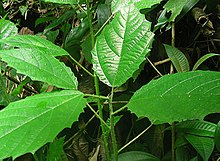| Tragia volubilis | |
|---|---|

| |
|
Scientific classification
| |
| Kingdom: | Plantae |
| Clade: | Tracheophytes |
| Clade: | Angiosperms |
| Clade: | Eudicots |
| Clade: | Rosids |
| Order: | Malpighiales |
| Family: | Euphorbiaceae |
| Genus: | Tragia |
| Species: | T. volubilis
|
| Binomial name | |
| Tragia volubilis | |
Tragia volubilis also known as fireman [2] is a climbing subshrub or climbing shrub native to tropical America and Africa. [1] It belongs to the Euphorbiaceae family, Tragia genus. As many of the species of the genus, it has stinging hairs, similar to those of nettles.
Distribution
The species is distributed from Mexico and the Caribbean to Argentina, and in Central Africa. [1]
Uses
It is used as a poison [2] and also as a medicinal plant with diuretic and anti STD uses. [3]
Phytochemistry
The methanolic extract of the aerial parts of the plant contains alkaloids, flavonoids and tannins. Avicularin, quercitrin, afzelin and amentoflavone were isolated and identified from the extract. The biological activity of these compounds supports the ethnomedical uses of the plant. [4]
Partitions of the aqueous extract of T. volubilis reduce the activity of the chemotherapeutic doxorubicin. [5]
References
- ^ a b c "Tragia volubilis L. | Plants of the World Online | Kew Science". Plants of the World Online. Retrieved 2023-06-11.
- ^ a b "ITIS - Report: Tragia volubilis". www.itis.gov. Retrieved 2022-12-23.
- ^ Duarte-Casar, Rodrigo; Romero-Benavides, Juan Carlos (December 2021). "Tragia L. Genus: Ethnopharmacological Use, Phytochemical Composition and Biological Activity". Plants. 10 (12): 2717. doi: 10.3390/plants10122717. ISSN 2223-7747. PMC 8705345. PMID 34961188.
- ^ Romero-Benavides, Juan Carlos; Atiencie-Valarezo, Nora Cecilia; Duarte-Casar, Rodrigo (January 2023). "Flavonoid Composition and Antioxidant Activity of Tragia volubilis L. Methanolic Extract". Plants. 12 (17): 3139. doi: 10.3390/plants12173139. ISSN 2223-7747. PMC 10490261. PMID 37687385.
- ^ Bailon-Moscoso, Natalia; Coronel-Hidalgo, José; Duarte-Casar, Rodrigo; Guamán-Ortiz, Luis Miguel; Figueroa, Jorge G.; Romero-Benavides, Juan Carlos (November 2023). "Exploring the Antioxidant Potential of Tragia volubilis L.: Mitigating Chemotherapeutic Effects of Doxorubicin on Tumor Cells". Antioxidants. 12 (11): 2003. doi: 10.3390/antiox12112003. ISSN 2076-3921. PMC 10669231. PMID 38001856.
- ^ "Tragia volubilis in Global Plants on JSTOR". plants.jstor.org. Retrieved 11 June 2023.
| Tragia volubilis | |
|---|---|

| |
|
Scientific classification
| |
| Kingdom: | Plantae |
| Clade: | Tracheophytes |
| Clade: | Angiosperms |
| Clade: | Eudicots |
| Clade: | Rosids |
| Order: | Malpighiales |
| Family: | Euphorbiaceae |
| Genus: | Tragia |
| Species: | T. volubilis
|
| Binomial name | |
| Tragia volubilis | |
Tragia volubilis also known as fireman [2] is a climbing subshrub or climbing shrub native to tropical America and Africa. [1] It belongs to the Euphorbiaceae family, Tragia genus. As many of the species of the genus, it has stinging hairs, similar to those of nettles.
Distribution
The species is distributed from Mexico and the Caribbean to Argentina, and in Central Africa. [1]
Uses
It is used as a poison [2] and also as a medicinal plant with diuretic and anti STD uses. [3]
Phytochemistry
The methanolic extract of the aerial parts of the plant contains alkaloids, flavonoids and tannins. Avicularin, quercitrin, afzelin and amentoflavone were isolated and identified from the extract. The biological activity of these compounds supports the ethnomedical uses of the plant. [4]
Partitions of the aqueous extract of T. volubilis reduce the activity of the chemotherapeutic doxorubicin. [5]
References
- ^ a b c "Tragia volubilis L. | Plants of the World Online | Kew Science". Plants of the World Online. Retrieved 2023-06-11.
- ^ a b "ITIS - Report: Tragia volubilis". www.itis.gov. Retrieved 2022-12-23.
- ^ Duarte-Casar, Rodrigo; Romero-Benavides, Juan Carlos (December 2021). "Tragia L. Genus: Ethnopharmacological Use, Phytochemical Composition and Biological Activity". Plants. 10 (12): 2717. doi: 10.3390/plants10122717. ISSN 2223-7747. PMC 8705345. PMID 34961188.
- ^ Romero-Benavides, Juan Carlos; Atiencie-Valarezo, Nora Cecilia; Duarte-Casar, Rodrigo (January 2023). "Flavonoid Composition and Antioxidant Activity of Tragia volubilis L. Methanolic Extract". Plants. 12 (17): 3139. doi: 10.3390/plants12173139. ISSN 2223-7747. PMC 10490261. PMID 37687385.
- ^ Bailon-Moscoso, Natalia; Coronel-Hidalgo, José; Duarte-Casar, Rodrigo; Guamán-Ortiz, Luis Miguel; Figueroa, Jorge G.; Romero-Benavides, Juan Carlos (November 2023). "Exploring the Antioxidant Potential of Tragia volubilis L.: Mitigating Chemotherapeutic Effects of Doxorubicin on Tumor Cells". Antioxidants. 12 (11): 2003. doi: 10.3390/antiox12112003. ISSN 2076-3921. PMC 10669231. PMID 38001856.
- ^ "Tragia volubilis in Global Plants on JSTOR". plants.jstor.org. Retrieved 11 June 2023.